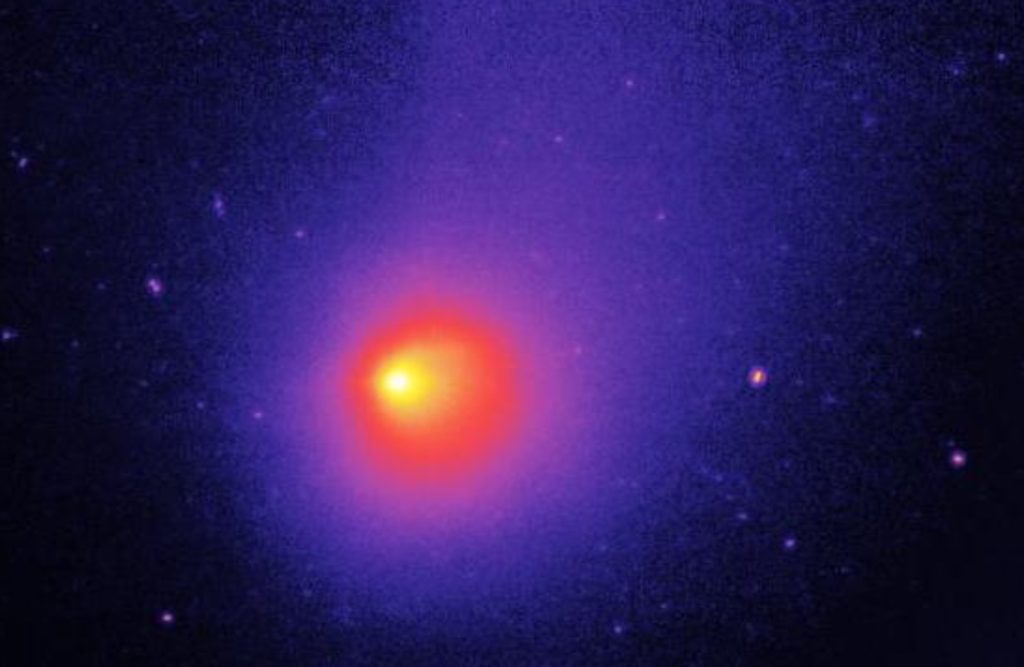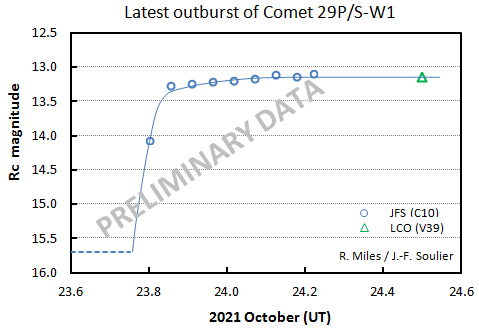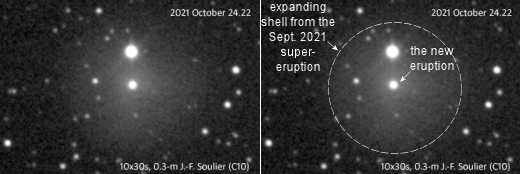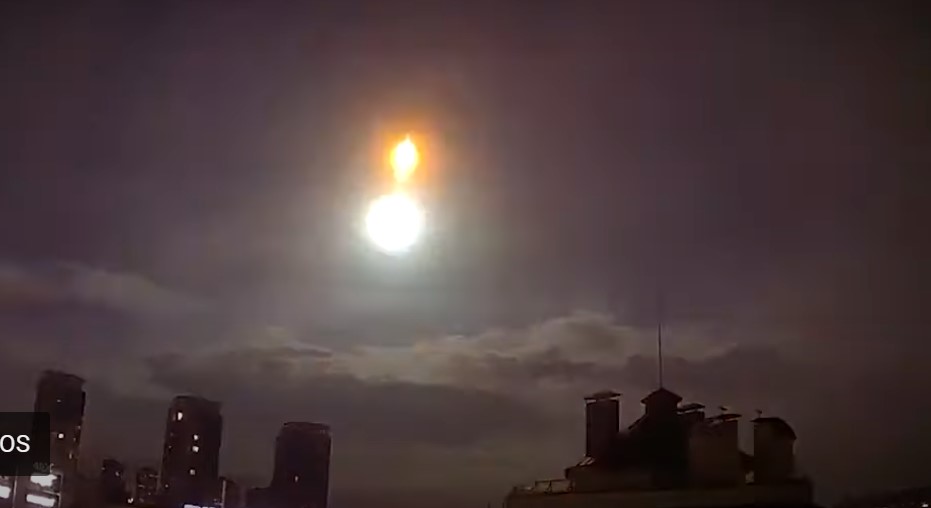
Comet 29P is one of the strangest objects in the solar system and is recently behaving even more weirdly.
The British Astronomical Association (BAA) is reporting another strong outburst of Comet 29P/Schwassmann-Wachmann. The volcanic comet suddenly brightened 10-fold on Oct. 23.75 UT when a sunlit vent opened, spewing ‘cryomagma’ into space.

Mysterious comet P29
Comet 29P is one of the weirdest objects in the solar system. In fact, it strains the definition of “comet.” 29P is a ball of ice 60 km wide (much larger than a typical comet) trapped in a planet-like orbit between Jupiter and Saturn. It appears to be festooned with ice volcanoes which erupt ~20 times a year.
A rapidfire “super-eruption” of 4 volcanoes in late September created an expanding shell of vaporized cryomagma, which astronomers have been monitoring. Yesterday’s eruption propelled a new compact shell into the old larger one:

29P rotates once every ~58 days. As sunlight sweeps across its frozen surface, cryovolcanoes erupt under the high sun. “The latest eruption has taken place some 59 days after a similar event on August 25th, and may be an example of an outburst from the same cryovolcano erupting a second time on the next rotation of the nucleus,” says Miles. Check Mission 29P for updates.
Comet 29P/Schwassmann–Wachmann characteristics
Comet 29P/Schwassmann–Wachmann, also known as Schwassmann–Wachmann 1, was discovered on November 15, 1927, by Arnold Schwassmann and Arno Arthur Wachmann at the Hamburg Observatory in Bergedorf, Germany.
The comet is unusual in that while normally hovering at around 16th magnitude, it suddenly undergoes an outburst. This causes the comet to brighten by 1 to 5 magnitudes.
This happens with a frequency of 7.3 outbursts per year, fading within a week or two. The magnitude of the comet has been known to vary from 18th magnitude to 10th magnitude, a more than thousand-fold increase in brightness, during its brightest outbursts.
On 14 January 2021, an outburst was observed with brightness from 16.6 to 15.0 magnitude, and consistent with the 7.3 outbursts per year noted earlier.
Outbursts are very sudden, rising to maximum in about 2 hours, which is indicative of their cryovolcanic origin; and with the times of outburst modulated by an underlying 57-day periodicity possibly suggesting that its large nucleus is an extremely slow rotator.
The comet nucleus is estimated to be 60.4±7.4 kilometers in diameter.
The comet is a member of a relatively new class of objects called “Centaurs”, of which at least 500 are known. These are small icy bodies with orbits between those of Jupiter and Neptune.
Astronomers believe that Centaurs have been recently perturbed inward from the Kuiper belt, a disk of Trans-Neptunian Objects occupying a region extending from the orbit of Neptune to approximately 50 AU from the Sun. Frequent perturbations by Jupiter will likely accumulate and cause the comet to migrate either inward or outward by the year 4000.
A number of Centaurs appear to be dynamically and perhaps even physically related to 29P; such objects may traverse the coma of 29P when in outburst.
The dust and gas comprising the comet’s nucleus is part of the same primordial materials from which the Sun and planets were formed billions of years ago. The complex carbon-rich molecules they contain may have provided some of the raw materials from which life originated on Earth.
29P reached perihelion on March 7, 2019 and has just come to opposition on November 6, 2020.
Another huge comet was discovered a few months ago. It may even be a small planetesimal, actually!
Now subscribe to this blog to get more amazing news curated just for you right in your inbox on a daily basis (here an example of our new newsletter).
You can also follow us on Facebook and/ or Twitter. And, by the way you can also make a donation through Paypal. Thank you!
You should really subscribe to QFiles. You will get very interesting information about strange events around the world.













LABREA SERIES WATCH IT>>PARA-REL UNIVERSE
Weird paradox.